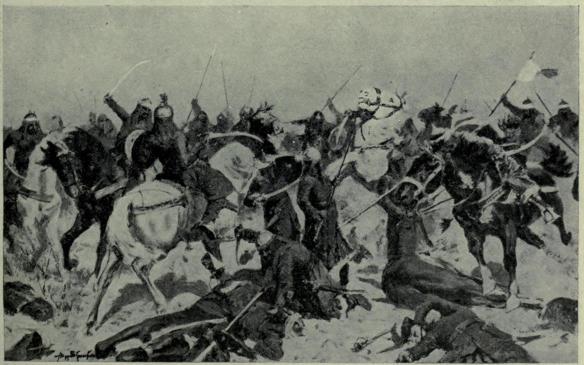The 1192 Battle of Taraori led to Muslim rule in India. Islam had been known in India through Muslim traders since soon after the death of the Prophet Muhammad in 632. The first Muslim military expedition against India occurred in 637, and in 712 Muhammad ibn Kasim invaded and conquered the impoverished north Indian province of Sind. There was, however, no Arab military move against the interior of the subcontinent.
It would not be the Arabs but rather the steppe Ottomans who, having conquered Persia and Afghanistan, would carry the Muslim faith into India. In 1000 Mahmud of Ghazni launched the first of 16 military expeditions that occurred over a 26-year period into Hindustan, in northern India. His objectives were both monetary and religious. He sought to acquire the wealth of India, but he also wanted to propagate the faith and eradicate what he regarded as the “false” Indian religions. His wanton destruction of Indian temples made him known as the “Idol Breaker.” Mahmud looted but did not build, yet for a time his capital of Ghazni was one of the world’s wealthiest cities.
Early in the 12th century, Ghazni came under challenge from the Afghan fortress city of Ghor. The struggle between Ghor and Ghazni was at first inconclusive, but in 1174 the soldiers of Ghor triumphed when Ghiyas-ad-Din captured Ghazni and placed his brother Muizz-al-Din on its throne. The latter came to be known as Muhammad of Ghor.
Muhammad of Ghor immediately set out to expand his influence into India. In 1182 he conquered Sind, and three years later he secured control of Punjab, in northwestern India, and westernmost Hindustan. Where his predecessors had relied on Hindu levies, Muhammad employed only Ottomans and Afghans, reliable Muslims who would be zealous in carrying out a religious war against Hindus.
In the winter of 1190-1191 Muhammad invaded south from the Punjab into Rajputana. That state’s soldiers were skilled and well-disciplined fighters and were loyal to their ruler, King Prithvaraja, who was also a capable general. Muhammad’s troops soon captured the border fortress town of Bhatinda and garrisoned it with 1,200 cavalry. King Prithvaraja immediately responded; the battle between the two sides occurred near Panipat, some 90 miles north of Delhi. Panipat is known variously as Tarain, Narain, and, most recently, Taraori. No precise date for the battle is available, but it took place in 1191. The size of the armies is also not known, although reputedly the Rajputs were the more numerous.
The battle began with Muhammad launching a cavalry attack, firing off arrows, against the Rajput center. The Rajputs stood firm, mounting flanking attacks that forced a Muslim retreat. To save the situation, Muhammad led a charge at the enemy line. Reportedly he fought personally with King Prithvaraja’s brother, Go-vind Tai, Viceroy of Delhi. Govind Tai was mortally wounded but managed to wound Muhammad seriously in the arm. Muhammad escaped and joined his retreating army, which withdrew back to Ghor. Rather than pursue, the Rajputs proceeded to Bhatinda, which they recaptured only after a 13-month siege.
Muhammad recovered from his wound and mounted a new campaign the next year with a large force of Afghans, Persians, and Ottomans that may have totaled
120,000 men. The battle occurred sometime in 1192 on the same battlefield, although this time Muhammad was careful not to close with the well-disciplined Rajputs. He formed his army in five divisions and sent four of these to attack the Rajput flanks and rear. If pressed, they were to feign retreat to try to break the Rajput unit cohesion.
The flanking attacks failed in their design, and the fighting continued for most of the day. When Muhammad ordered his fifth division to pretend to withdraw in panic, the ruse worked. The Rajputs charged, breaking their unit cohesion. Muhammad then threw a fresh cavalry unit of 12,000 men into the battle, and they threw back the Rajput advance. The remaining Muslim forces turned and pursued, sending the Rajputs fleeing in panic.
With the Muslims almost on him, King Prithvanaja abandoned his elephant for a horse in an attempt to escape. He was ridden down and captured some miles from the battlefield and was promptly executed. Most of his subordinate commanders were also killed.
Muhammad annexed Rajputana, but he was not content with this. With the victory at Taraori, there was no armed force in India capable of withstanding him. In 1193 his forces took Bihar Province, the center of Buddhism. They virtually eradicated Buddhism there, forcing its practitioners to flee to Tibet and Nepal and thus ensuring that this religion would spread in China and not India. Over the next several years his armies expanded his control to the east and throughout northern India. In 1202 one of the armies reached Bengal, completing the annexation of Hindustan.
Muhammad also sought to expand his power in Persia and the Middle East but was defeated in his invasion of Khwarizm (Kiva) in 1203. At the end of the 13th century the Mongols arrived, defeating in turn the ruling Muslim dynasty in northern India and establishing the Moghul dynasty that ruled India until the British officially ended it in 1857. The religious divisions of India continued, and in 1948 irreconcilable differences led to the establishment of an independent Hindu India and Muslim Pakistan.
References
Davis, Paul K. 100 Decisive Battles: From Ancient Times to the Present. Santa Barbara, CA: ABC-CLIO, 1999.
Haig, Wolseley, ed. The Cambridge History of India, Vol. 3. Delhi: S. Chand, 1965.
Kar, H. C. Military History of India. Calcutta: Firma KLM, 1980.
